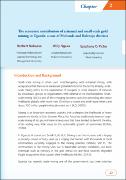| dc.contributor.author | Picho, Epiphany Odubuker | |
| dc.contributor.author | Nabaasa, Herbert | |
| dc.contributor.author | Ngaka, Willy | |
| dc.date.accessioned | 2018-11-19T11:32:14Z | |
| dc.date.available | 2018-11-19T11:32:14Z | |
| dc.date.issued | 2016-06 | |
| dc.identifier.citation | Nabaasa, H, Picho, E.O;& Ngaka, W. (2016). The economic contribution of Artisanal and Small scale gold mining in Uganda: a case of Mubende and Buhweju districts. International Journal of Technology and Management 2(2). | en_US |
| dc.identifier.uri | http://dir.muni.ac.ug/xmlui/handle/20.500.12260/299 | |
| dc.description.abstract | Small-scale mining is often used interchangeably with artisanal mining, with acceptance that there is no consistent global definition for the terms. Broadly, smallscale mining refers to the exploitation of marginal or small deposits of minerals by individuals, groups or organizations with minimal or no mechanization. Smallscale mining (SM) is one of the emerging economic activities providing alternative livelihoods globally with more than 13 million artisanal and small-scale miners and about 150 million people indirectly reliant on it (ILO, 2003). In Uganda, Artisanal and Small-Scale Gold Mining is on the increase and is largely a poverty-driven activity used as a coping mechanism with thousands of local communities currently engaged in the mining practice (MEMD, 2011). The communities in the mining sites live in deplorable sanitary conditions, use toxic chemicals such as mercury in the gold extraction and have severely degraded fragile ecosystems that support their livelihoods (NEMA, 2012). | en_US |
| dc.publisher | International Journal of Technology and Management | en_US |
| dc.subject | Small-scale mining | en_US |
| dc.subject | Gold mining | en_US |
| dc.subject | Artisanal Gold Mining | en_US |
| dc.title | The economic contribution of artisanal and small-scale gold mining in Uganda: a case of Mubende and Buhweju districts | en_US |
| dc.type | Article | en_US |

